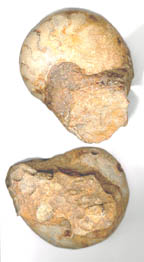 |
Rounded quartz sand grains betray the past presence of ancient aeolian (wind-blown) sand dunes in the rainforest zone of southern Nigeria. The rounded aeolian grains become abraded by numerous conchoidal percussion fractures during saltation in desert storms, then smoothened when stationary by silica precipitation. The windblown grains are intermixed with Coastal Plain Sands, the angular to sub-angular grains of which may indicate fluvial deposition. The rounded grains were then re-worked by the wind during one of Africa's many severe arid phases. Other indicators include laterite outcrops and relict drainage patterns orientated east-north-east/west-south-west in many locations of Africa ... including the areas of past supposed rainforest refugia during the last ice-age. |
| The arid phase causing these seif dunes indicates
that Saharan Desert conditions came within 1-6 degrees of the equator (even
as the Kalahari Desert approached south of the equator). This would have
caused the rainforest to retreat to strips of gallery forest, montane forest
and - perhaps - a few other small areas. In Biological terms, there are
immense implications for Africa's high level of species endemism; savannah
biota devolving into rainforest biota; the rate of species adaptation to
rapid climatic change; and long-term conservation planning.
In Archaeological terms, this sheer severity of an arid phase causing desert sand dunes to nearly meet one another at the equator has immense implications for early man. Until this arid phase has been dated, it will not be clear whether it affected very early man 250,000 years ago, the move of Homo sapiens 'Out of Africa' 40,000 years ago, the Bantu expansion over a third of the African continent some 2,000 years ago, or was the catylyst for state formation processes about 1,300-1,400 years ago. |

Left: rounded grain from fossil dune (Smith & Whalley, 1981). Right: frosted 'millet seed' sand grains from past desert environment (Holmes, 1965). See also Krinsley & Doorncamp (1973:63) |

